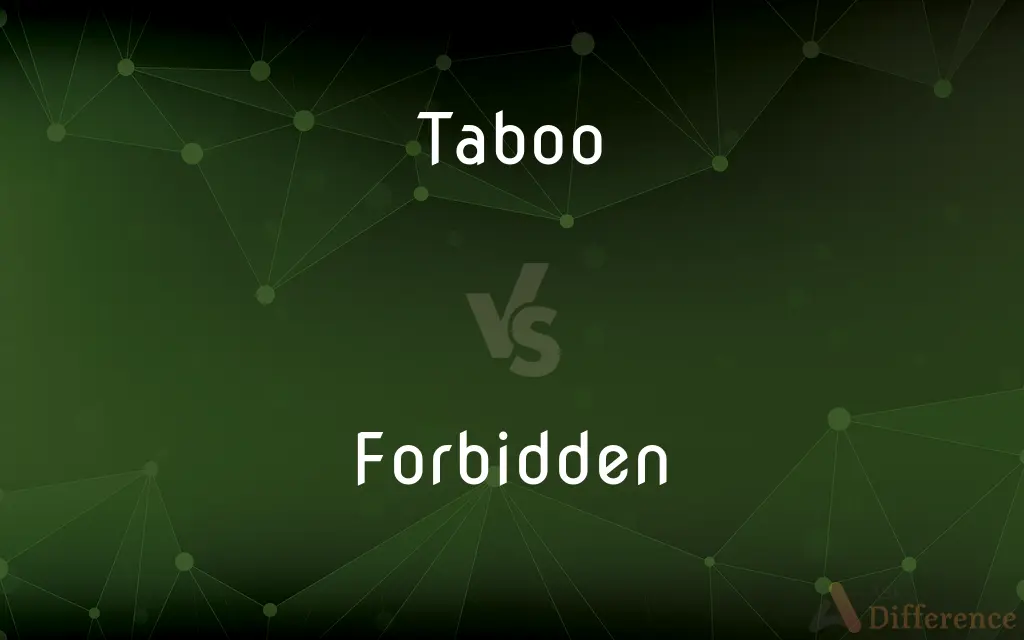Taboo vs. Forbidden — What's the Difference?
By Maham Liaqat & Urooj Arif — Updated on February 27, 2024
Taboo refers to behaviors socially or culturally prohibited due to religious, moral, or societal norms, carrying sense of impurity. Forbidden actions are explicitly prohibited by law, rules, or direct orders, lacking the religious connotations of taboos.

Difference Between Taboo and Forbidden
Table of Contents
ADVERTISEMENT
Key Differences
Taboo encompasses actions or behaviors that are prohibited within a particular culture or society because they are considered morally unacceptable, unclean, or sacred. These prohibitions are often unwritten and passed down through generations, embedding deeply in the social fabric. Forbidden, however, refers to actions or behaviors explicitly prohibited by a specific authority, such as laws, regulations, or direct commands. This distinction implies that while all taboos are prohibitions, not all prohibitions are considered taboos.
Taboos often carry a significant cultural and emotional weight, rooted in tradition, religion, or superstition. They can govern a wide range of activities from dietary restrictions to social interactions, with violations leading to social ostracization or worse. Forbidden actions, in contrast, are typically defined by legal or formal rules, with specified penalties for violations. These can change with laws and are enforced by an identifiable authority rather than community consensus.
The origins of taboos are usually ancient and tied to the collective identity of a community, making them more resistant to change. They serve to reinforce societal norms and values, often without a clear rationale beyond tradition. Forbidden actions, however, are usually the result of deliberate decisions by governing bodies or authorities and can be enacted or repealed as those authorities see fit, often with clear reasons provided.
Understanding taboos requires an appreciation of the cultural, religious, and societal contexts from which they arise. In contrast, understanding forbidden actions requires knowledge of the specific laws, regulations, or commands that define what is prohibited. This distinction highlights the complexity of navigating social norms and legal restrictions in diverse cultural and regulatory environments.
Taboos and forbidden actions both involve prohibitions, they originate from different sources, serve different purposes, and are enforced in different ways. Recognizing the distinction between them is crucial for navigating the complexities of social and legal conduct in any given context.
ADVERTISEMENT
Comparison Chart
Origin
Cultural, religious, or societal norms.
Laws, regulations, or direct orders.
Enforcement
Social ostracization or informal sanctions.
Legal penalties or direct authoritative actions.
Changeability
Resistant to change due to deep cultural roots.
Can be changed by modifying laws or rules.
Rationale
Often based on tradition, without clear rationale.
Typically has a clear, articulated rationale.
Examples
Dietary restrictions, incest, speaking of the dead.
Trespassing, unauthorized use of property.
Compare with Definitions
Taboo
Taboos involve cultural practices considered sacred or impure.
In many cultures, discussing death at the dinner table is a taboo.
Forbidden
They include actions against laws or rules.
Unauthorized access to confidential information is forbidden.
Taboo
They are enforced by social consensus rather than formal law.
Wearing hats indoors is taboo in certain societies.
Forbidden
The rationale for forbidden actions is usually articulated.
Texting while driving is forbidden to prevent accidents.
Taboo
Taboos can dictate social interactions.
Speaking directly to in-laws is taboo in some cultures.
Forbidden
Forbidden actions are explicitly prohibited by authority.
Smoking in public places is forbidden by law in many cities.
Taboo
Taboos often lack a clear rationale beyond tradition.
Certain animals are taboo as food without a specific reason except tradition.
Forbidden
Penalties for forbidden actions are clearly defined.
Trespassing on private property is forbidden and may result in arrest.
Taboo
Violating a taboo can lead to social ostracization.
Breaking a dietary taboo can result in exclusion from community events.
Forbidden
Forbidden rules can be changed by legislative action.
Drinking alcohol was once forbidden during Prohibition in the U.S.
Taboo
A taboo is an implicit prohibition on something (usually against an utterance or behavior) based on a cultural sense that it is excessively repulsive or, perhaps, too sacred for ordinary people. Such prohibitions are present in virtually all societies.
Forbidden
Not allowed; banned
A list of forbidden books
Taboo
A social or religious custom prohibiting or restricting a particular practice or forbidding association with a particular person, place, or thing
Freud applies his notion of taboo in three ways
The use of violence must remain a taboo in our society
Many taboos have developed around physical exposure
Forbidden
Not allowed; not permitted
A sign at the entrance of the park lists forbidden substances, such as drugs and alcohol.
Common Curiosities
What makes an action taboo?
An action becomes taboo when it is socially or culturally prohibited due to moral, religious, or societal norms.
How do societies determine what is taboo?
Societies determine taboos based on long-standing traditions, religious beliefs, and collective moral values.
How are forbidden actions enforced?
Forbidden actions are enforced through legal penalties or direct authoritative measures.
Can a taboo become legally forbidden?
Yes, a taboo can become legally forbidden if laws are enacted to prohibit the taboo behavior.
Is it possible for a forbidden action to not be culturally taboo?
Yes, it is possible for an action to be legally forbidden without being culturally taboo, especially if the prohibition is based on safety or regulatory reasons rather than cultural norms.
Are all forbidden actions considered taboos?
No, not all forbidden actions are considered taboos since taboos have cultural or religious connotations that forbidden actions might not.
Can the concept of taboo vary between cultures?
Yes, what is considered taboo can vary greatly between cultures, reflecting the diversity of moral and societal norms.
How does globalization affect taboos?
Globalization can lead to the blending and sometimes the erosion of taboos as cultures interact and exchange values.
What happens if someone violates a taboo?
Violating a taboo can lead to social ostracization, shame, or other forms of informal punishment.
What is the difference between a taboo and a social faux pas?
A taboo is a serious prohibition based on moral, cultural, or religious norms, while a social faux pas is a minor breach of etiquette.
How do taboos change over time?
Taboos can change as societal values evolve, but this usually happens slowly due to their deep cultural roots.
What role do religious beliefs play in taboos?
Religious beliefs often play a significant role in establishing taboos, with certain actions being prohibited based on religious doctrine.
Can an action be both taboo and forbidden?
Yes, an action can be both taboo and forbidden if it is culturally prohibited and also explicitly outlawed.
Why are some actions forbidden by law?
Actions are forbidden by law to protect individuals' rights, ensure public safety, and maintain social order.
How do individuals learn about taboos and forbidden actions?
Individuals learn about taboos and forbidden actions through socialization, education, and direct communication from authorities or community members.
Share Your Discovery

Previous Comparison
Hero vs. Martyr
Next Comparison
Cane vs. CrutchAuthor Spotlight
Written by
Maham LiaqatCo-written by
Urooj ArifUrooj is a skilled content writer at Ask Difference, known for her exceptional ability to simplify complex topics into engaging and informative content. With a passion for research and a flair for clear, concise writing, she consistently delivers articles that resonate with our diverse audience.
















































